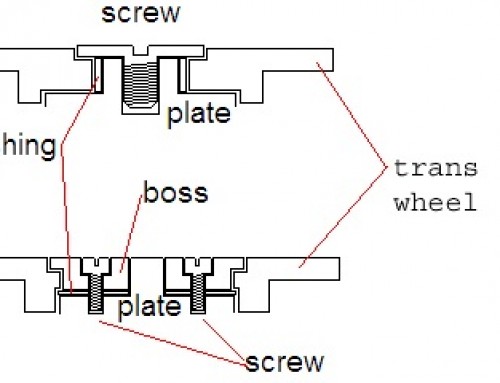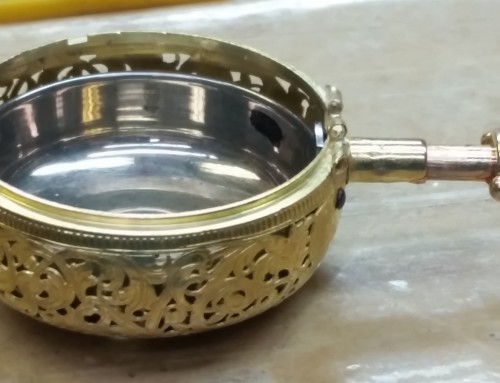Old enameled dials often have broken or missing dial feet, fine hairline cracks, and broken out or loose center or seconds bits. Most dials will have some small chips some place on their surface, especially between 12:00 and 3:00 which is where most cases have tabs to facilitate opening, also set levers are usually between these points.
Hairlines are fine cracks in the surface of the dial, they are caused from several things such as age, and stress from poor handling like someone prying the dial of without loosening the dial screws. These fine cracks are almost invisible until they fill with dust and dirt, if you can get the dirt out of these cracks they will be far less visible.
Broken dial feet and loose bits are almost always the direct result of poor handling from past inexperienced persons and can be tough to repair.
With a little patients, common sense and practice most damaged dials can be made to look quite good again.
It should be mentioned that soldering dial feet and dial bits takes a lot of care and practice, if the dial is accidentally heated to hot it will be damaged for sure. So practice on junk dials until you are very confident with your skills. I have repaired many dials over the years and it still makes me nervous.
Repairing chips Making hairlines less visible Repairing center and seconds dial bits Replacing dial feet
What you will need to repair chips
Dial repair medium, which is a white wax like substance available from most distributors.
A very clean and neatly sharpened flat ended metal tool, a 2.50 mm screw driver works well.
Watch paper.
Plastic scraping tool, a guitar pick or the edge of a small plastic box will work well.
Heat source, like a torch or an alcohol lamp.
Razor blade.
Sharp pointed scribe.
Fine tipped permanent marker.
What to do
1. Ultrasonically clean dial.
2. Be sure any old dial repair material has been removed.
3. Heat end of flat tipped tool slightly, dip it into dial repair medium, and pick up a small chunk.
4. Place the chunk of dial repair medium into the chip, and repeat until chip is slightly over filled, keep heating the tool to keep the dial repair medium slightly liquid but do not heat it to hot or it will discolor or burn.
5. When completely cooled use a very sharp razor blade to lightly scrape away excess until it is almost flush with dial surface.
6. Using plastic scraper, lightly scrape scrape until smooth and flush with surface. Using a plastic scraper eliminates the risk of scratching the dial.
7. Use scribe to mark lines such as for the seconds or center bits, sometimes a compass works well for this.
8. Rub with watch paper until a high polish is attained.
9. Use permanent marker of the appropriate color to repaint missing numbers or markings.
Do not touch dial surface with fingers, hold dial only by edges.
Sometimes heating the dial very slightly from the under side will help to level the dial repair medium. Be very careful not to heat it very much!
The color of the repair medium can be altered to match the dial by adding pigment from small amounts of dried paint of the right shade mixed with 111 Trichloroethylene ( One-Dip ) This procedure takes a lot of practice to get right but works incredibly well.
111 Trichloroethylene ( One-Dip ) will thin and/or remove hardened dial repair medium and most other waxes making it very useful.
Apply the least possible amount of dial repair medium to the chip because the more you apply the more you have to scrape away.
Do not place dial in any liquid after the repair in made or discoloration may result.
If your ultrasonic machine is a very powerful one take care to assure the dial doesn’t get damaged by keeping it as far away from the transducer as possible and you may also have to shorten the soak time.
What you will need to make hairlines less visible
Ultrasonic cleaning tank.
Strong detergent, Castrol super clean brand cleaner works very well and is available at most department stores.
Stiff dial brush.
What to do
1. Clean dial ultrasonically for about four or five minutes in a strong detergent, again Castrol super clean brand cleaner works very well for this. Brush dial with dial brush half way through cleaning.
2. Rinse dial with fresh hot running water.
3. Cover and let dial air dry.
Do not touch the face of the dial with your fingers hold it by the edges.
Do not dry the dial with a paper towel or cloth, wiping or touching the dial will introduce small particles into the hairlines and make them visible again.
If your ultrasonic machine is a very powerful one take care to assure the dial doesn’t get damaged by keeping it as far away from the transducer as possible and you may also have to shorten the soak time
If your tap water has a high concentration of minerals the minerals may deposit into the hairlines. Use hot filtered or distilled water.
When drying dial be sure to cover it so dust doesn’t collect on it’s surface or in the hairlines.
What you will need to repair loose dial bits
Soft solder, Tix brand works very well.
Soft solder flux, again Tix brand works very well.
Heat resistant soldering block.
Torch ( preferably ).
Files.
Again it should be mentioned that soldering dial feet and dial bits takes a lot of care and practice, if the dial is accidentally heated to hot it will be damaged for sure. So practice on junk dials until you are very confident with your skills.
What to do
If you are unsure of you ability simply use epoxy instead of solder, following steps 1-4 and then place a small amount of epoxy around the perimeter of the grove.
1. Remove all old solder or glue until you have bright and clean copper showing, this can be done by filing, or scraping. ( take care not to file away the copper or the grove will be made to big and the solder will not flow around the grove )
2. Ultrasonically clean dial and dial bit.
3. Place dial face down on a clean soldering pad.
4. Arrange dial bit to it’s proper position.
5. Apply a small amount of flux to the perimeter of the bit.
6. Cut soft solder into small pieces about 1.0 – 1.5 mm in length.
7. Place soft solder pieces into the solder grove.
8. Heat the dial a very slowly using a low temp flame until the solder just starts to flow then follow the grove slowly with the flame until the solder has flowed all the way around.
Do not drop dial in any liquid while it is hot.
Do not touch dial until solder has hardened.
When heating the dial I can’t stress enough the importance of heating it slow and with a low temp flame. Use sweeping motions when heating dial like you would do for spray painting this prevents hot spots which will cause enamel to chip and pop off. When you see the flux start to boil vigorously move the flame back, usually the solder will flow immediately after flux boils.
If your ultrasonic machine is a very powerful one take care to assure the dial doesn’t get damaged by keeping it as far away from the transducer as possible and you may also have to shorten the soak time.
What you will need to replace missing dial feet
Ready made dial foot assortment, available from most distributors. Dial feet can also be made using a lathe and should be made of copper.
Soft solder, Tix brand works very well.
Soft solder flux, again Tix brand works very well.
Heat resistant soldering block.
Torch
Files.
What to do
If you are unsure of you ability simply use epoxy instead of solder, following steps 1-4 and then place a small amount of epoxy on the bottom of the foot.
1. File away the leftover part of the old foot until you have it flush with the surface of the dial.
2. Ultrasonically clean the dial.
3. Place dial face down on a clean soldering pad.
4. Arrange new dial foot to it’s proper position.
5. Apply a small amount of flux to the bottom of the foot.
6. Cut soft solder into small pieces about 1.0 – 1.5 mm in length.
7. Place soft solder pieces next to edge of foot so solder is resting on edge.
8. Heat the dial very slowly using a low temp flame until the solder has flowed all the way around.
Do not drop dial in any liquid while it is hot.
Do not touch dial until solder has hardened.
When heating the dial I can’t stress enough the importance of heating it slow and with a low temp flame. Use sweeping motions when heating dial like you would do for spray painting this prevents hot spots which will cause enamel to chip and pop off. When you see the flux start to boil vigorously move the flame back, usually the solder will flow immediately after flux boils.
Again if you are unsure of you ability simply use epoxy instead of solder, following steps 1-4 and then place a small amount of epoxy around the perimeter of the grove.
If your ultrasonic machine is a very powerful one take care to assure the dial doesn’t get damaged by keeping it as far away from the transducer as possible and you may also have to shorten the soak time.
Again it should be mentioned that soldering dial feet and dial bits takes a lot of care and practice, if the dial is accidentally heated to hot it will be damaged for sure. So practice on junk dials until you are very confident with your skills.
![]()





